Abstract
Nickel-doped titanium dioxide (NIT) with different nickel contents (0.1–1.0 wt%) was prepared via the sol–gel method, combined with mechanical ball milling. X-ray diffraction (XRD), scanning electron microscopy (SEM), and UV–Vis diffuse reflectance spectroscopy (DRS) were employed to characterize the crystalline structure, morphological characteristics, and optical properties of the samples. The photocatalytic activity was evaluated through the photocatalytic degradation of methylene blue (MB) under visible light and nitric oxide (NO) under simulated sunlight. The XRD results show that all the catalysts retain the anatase phase, confirming that nickel doping does not alter the crystalline structure of TiO2. NIT catalysts exhibited a plate-like morphology due to the ball milling treatment of the precursors. The DRS analysis revealed that nickel modification induced a redshift in the absorption edge of TiO2 and enhanced the visible-light absorption. The photocatalytic tests demonstrated that 0.5 wt% NIT and 0.7 wt% NIT exhibited the highest photocatalytic activity for MB degradation, achieving degradation rates of 93.1% and 91.4% after 60 min, respectively. Moreover, 0.7 wt% NIT showed the optimal NO conversion efficiency of 45.4% after 30 min. The improved photocatalytic performance of the sample is attributed to enhanced visible-light absorption, reduced charge recombination, and a high specific surface area. This study provides a facile strategy for synthesizing Ni-doped TiO2 nanoplates based on the sol–gel method, which is scalable in regard to the industrial production of efficient photocatalysts.
1. Introduction
With the advancement of science and technology and rapid industrial development, water and air pollution have become increasingly severe. Addressing environmental pollution has emerged as a critical challenge in regard to green development strategies. Industrial wastewater and exhaust emissions, in recent years, have imposed significant adverse impacts on ecosystems and public health. Mobile-source emissions constitute a major contributor to air pollution, while the growing demand for clean water, driven by industrialization, population expansion, and prolonged droughts, has led to global water scarcity [1]. Consequently, the urgency to enhance air pollution control and secure clean water resources has become critically prominent.
The application of photocatalytic technology in regard to environmental remediation has been extensively investigated due to its environmentally friendly nature and high efficiency, making it a promising approach for sustainable pollution control. Photocatalysts can be categorized into various types, including metal oxides (e.g., TiO2, Fe2O3, ZnO), metal sulfides (e.g., CdS, MoS2), Bi-based photocatalysts (BiOX, X = Cl, Br, I), Ag-based photocatalysts (e.g., Ag3PO4, Ag2CrO4, AgBr), graphitic carbon nitride (g-C3N4), elemental semiconductors, and conjugated photocatalysts. Among these materials, titanium dioxide (TiO2) has been widely recognized as an exceptional photocatalyst for degrading organic pollutants, owing to its superior photocatalytic activity, robust oxidative capacity, non-toxicity, excellent stability, and cost effectiveness [2,3,4].
However, titanium dioxide (TiO2) suffers from inherent limitations that hinder its practical application, such as its narrow light absorption range, namely strong absorption in the ultraviolet (UV) region but weak visible-light utilization, resulting in low solar energy conversion efficiency (~4%) [5] and, consequently, poor photocatalytic activity under visible light. Additionally, rapid electron–hole recombination occurs under photoexcitation, wherein photogenerated charge carriers on the TiO2 surface readily recombine, significantly reducing its photocatalytic efficiency. To address these issues, ion doping strategies have been employed to broaden the visible-light response range and suppress electron–hole recombination. Metal dopants (e.g., Fe, Cr, Cu, Ce) have been widely utilized as co-catalysts to enhance TiO2 performance [6,7,8,9,10,11,12,13]. Nonmetallic doping (e.g., N, F, S, P, I) has also been adopted to modify the surface or bulk properties of TiO2, thereby improving its photocatalytic activity [14,15,16,17,18,19,20,21,22].
Related studies have shown that transition metal doping extends the light absorption range of TiO2 into the visible region. The 3d orbitals of transition metals enable electron excitation under visible light, while their unfilled 3d orbitals facilitate charge transfer between photogenerated electrons and holes. Additionally, the 3d orbitals of transition metals align with Ti3+ 3d orbitals, forming continuous energy levels within the conduction band [23]. Nickel, a cost-effective transition metal, has been extensively applied across multiple fields. Esfandian et al. [24] synthesized Ni-doped ZnO–TiO2 nanocomposites to investigate their electrochemical behavior and photocatalytic performance in regard to chlorpyrifos pesticide degradation. Mollavali et al. [25] enhanced the visible-light photocatalytic activity of TiO2 nanotube arrays (TNAs) via co-doping with nitrogen, nickel, and carbon. Varimalla et al. [26] demonstrated that rutile TiO2 serves as a more effective carrier for nickel than anatase. Gul et al. [27] fabricated NiO/TiO2 nanocomposites via chemical reduction, revealing its superior photocatalytic degradation efficiency and biological activity.
Numerous methods have been developed to synthesize TiO2, including the impregnation method [28], ceramic synthesis, precipitation, hydrothermal synthesis, and the sol–gel method [29,30,31,32,33]. The sol–gel method, widely adopted for preparing ultrafine metal oxides [34], is particularly prevalent in fabricating nano-TiO2. This method typically employs metal alkoxides or salts as precursors, with anhydrous ethanol as the organic solvent and acidic solutions as hydrolysis inhibitors. Upon the addition of deionized water, the precursor solution undergoes hydrolysis, polycondensation, and gelation [35].Velázquez-Martínez et al. [36] synthesized TiO2 and Fe-doped TiO2 micropowders via a sol–gel–hydrothermal hybrid approach, demonstrating a high level of photocatalytic activity in regard to azo dye degradation experiments. Cheng et al. [37] developed a water-free sol–gel strategy to prepare polyethylene glycol/titanium dioxide shape-stable composite phase change materials (PEG/TiO2 ss-CPCM), exhibiting advantages such as enhanced thermal energy storage capacity, shape stability, thermal reliability, and effective thermal management. Lal et al. [38] synthesized Nd-doped TiO2 nanoparticles via a sol–gel–ultrasonic route, achieving 96.42% degradation efficiency under sunlight irradiation. Yurtsever et al. [28] prepared Cu-doped and lanthanide–copper co-doped TiO2 powders using sol–gel synthesis, investigating the synergistic effects of co-doping on the photocatalytic redox activity.
In contrast to the hydrothermal and impregnation methods, the sol–gel method is characterized by its shorter processing time and higher yield. This study innovatively employs mechanical ball milling to pre-treat the precursor prior to calcination, thereby replacing traditional manual labor in the preparation of modified TiO2 via the conventional sol–gel approach. Mechanical ball milling leverages the high-speed movement of grinding media (such as steel or ceramic balls) within the mill to subject the precursor to impact, grinding, and stirring. This process ensures thorough and uniform mixing of the precursor with other additives at the microscopic level, thereby guaranteeing the consistent distribution of all the components. As a result, the subsequent reaction proceeds more uniformly, enhancing the quality and performance stability of titanium dioxide products. Furthermore, mechanical ball milling refines the particle size of the precursor before calcination, yielding a more uniform particle size distribution. This refinement is advantageous for the calcination process. Additionally, the limited exposure of the precursor to the external environment during grinding minimizes the risk of impurity contamination. The mechanical ball milling technique enables precise control over the grinding effect on the precursor, thereby achieving high actual production efficiency.
In this study, Ni-doped TiO2 catalysts with varying nickel contents were synthesized via a sol–gel method, combined with mechanical ball milling of the gel precursors. The photocatalytic performance of the catalysts was evaluated through the degradation of nitric oxide (NO) and methylene blue (MB). The crystal structure, morphology, and optical properties of the materials were characterized using UV–Vis spectroscopy, X-ray diffraction (XRD), X-ray photoelectron spectroscopy (XPS), and scanning electron microscopy (SEM). The results demonstrate that Ni doping and ball milling of the precursor significantly enhance its photocatalytic activity. A schematic illustration of the research process is presented in Figure 1.

Figure 1.
A schematic diagram of the research process. Solution A and B are the tetrabutyl titanate (or Nickel Nitrate + tetrabutyl titanate) solution and the glacial acetic acid solution.
2. Experimental Process
2.1. Catalyst Preparation
Firstly, 38 mL of anhydrous ethanol was added to a beaker, followed by 17 mL of tetrabutyl titanate. The mixture was magnetically stirred at 500 rpm for 10 min and ultrasonicated for 5 min, denoted as Solution A. In a separate beaker, 38 mL of anhydrous ethanol, 6 mL of glacial acetic acid, 12 mL of deionized water, and Ni(NO3)2·6H2O (Ni2+/Ti4+ mass ratios: 0.1, 0.3, 0.5, 0.7, 0.9, 1 wt%) were mixed, magnetically stirred for 20 min, and ultrasonicated until complete dissolution. The pH was adjusted to 2 using pH test paper, yielding Solution B. Solution B was added dropwise to Solution A at 2 drops/s via a rubber dropper, with continuous stirring until a sol-like mixture formed. The sol was then transferred to a 50 °C water bath and stirred until gelation occurred. The gel was aged at room temperature for 12 h, dried at 80 °C, and ground with 25 corundum balls (five balls: 1.0 cm diameter, 2.25 g each; 20 balls: 0.5 cm diameter, 0.26 g each) in a 50 mL zirconia ball mill at 100 rpm for 15 min, producing Ni2+/Ti4+-modified TiO₂ precursors (0.1–1 wt%). Finally, the precursors were calcined in a muffle furnace at 500 °C (heating rate: 5 °C/min) for 2 h in air, followed by cooling to 50 °C at 5 °C/min. The resulting catalysts were labeled as x% NIT (x = 0.1, 0.3, 0.5, 0.7, 0.9, 1).
Pure TiO2 was synthesized using an identical procedure to the Ni-doped samples but omitting Ni(NO3)2·6H2O in Solution B, denoted as T.
2.2. Catalyst Characterization
The X-ray diffraction (XRD) analysis was conducted using a TD-3500 diffractometer (Dandong Tongda Science and Technology Co., Ltd., Dandong, China) in continuous scanning mode, with a biaxial linkage drive. The operating parameters were set as follows: voltage = 35 kV, current = 25 mA, scanning range = 10–80° (2θ), and scanning rate = 5°/min. The UV–Vis diffuse reflectance (DR) spectra were recorded using a Shimadzu UV-2600 spectrophotometer (Shimadzu Co., Ltd., Hong Kong, China) (200–800 nm wavelength range). The surface morphology was characterized using a Zeiss Sigma 300 field-emission scanning electron microscope (FE-SEM) (Carl Zeiss Management Co., Ltd., Shanghai, China). High-resolution transmission electron microscopy (HRTEM) images and selected area electron diffraction (SAED) patterns were acquired with a Thermo Fisher Tecnai G2 F20 TEM (FEI Corporation, Hillsboro, OR, USA), operated at 200 kV. The X-ray photoelectron spectroscopy (XPS) analysis was performed using a Kratos AXIS Ultra DLD (Thermo Kalpha, Waltham, MA, USA) spectrometer, with monochromatic Al Kα radiation (hv = 1486.6 eV). Raman spectra were collected using a WITec Alpha-300R confocal Raman microscope (WITec GmbH, Ulm, Germany), over a spectral range of 100–800 cm−1. Nitrogen adsorption–desorption isotherms were measured at 77 K using a Micromeritics 3 Flex analyzer (McMurdik Instrument Co., Ltd., Shanghai, China). Prior to analysis, the samples were degassed at 150 °C under a vacuum for >6 h. The specific surface area was calculated via the Brunauer–Emmett–Teller (BET) method, while the pore size distribution was derived from the adsorption branches using the Barrett–Joyner–Halenda (BJH) model.
2.3. Photocatalytic Activity Evaluation
The photocatalytic degradation activities of T and Ni–TiO2 (NIT) were evaluated using methylene blue (MB) and nitric oxide (NO) as model pollutants. A schematic diagram of the NO degradation setup is illustrated in Figure 2. The photocatalytic procedure was conducted as follows:
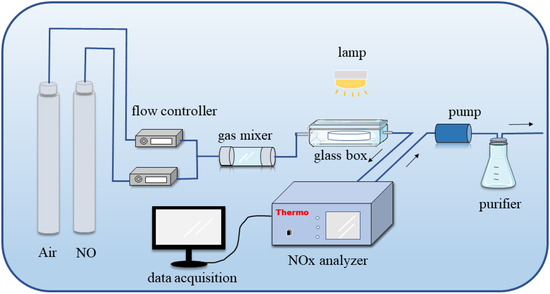
Figure 2.
A diagram of the devices involved in the photocatalytic degradation of NO.
For MB degradation, a BILON-CHX-V photoreactor (China Shanghai Bilon Instruments Manufacture Co., Ltd., Shanghai, China), equipped with a 300 W xenon lamp, was employed at 25 °C. In a typical experiment, 10 mg of catalyst was dispersed in 50 mL of MB solution (1 × 10−4 mol L−1) and stirred in the dark for 1 h to establish the adsorption–desorption equilibrium. At predetermined intervals, 1 mL aliquots were collected, centrifuged at 10,000 rpm for 5 min, and analyzed using a Japan Shimadzu UV-3600 UV–Vis spectrophotometer. The photodegradation efficiency was calculated via the following equation:
where C0 is the initial concentration of MB and Ct is the concentration of MB at a given irradiation time.
The photocatalytic degradation of NO was evaluated using a continuous-flow fixed-bed reactor (360 mm × 210 mm × 110 mm), equipped with a xenon lamp. The catalyst (200 mg) was evenly coated on the bottom of the reactor. A reactant mixture (5 vol% NO balanced with air) was introduced at a total flow rate of 900 mL·min⁻1, corresponding to a weight hourly space velocity (WHSV) of 270 L·g⁻1·h⁻1. The concentrations of NO and the products were monitored in real time using a Thermo Scientific 42i-TL NOₓ analyzer from the United States.
3. Results and Discussion
3.1. Photocatalytic Performance
3.1.1. Photodegradation of MB
Methylene blue (MB), a cationic thiazine dye, is widely employed in chemical and pharmaceutical industries. In an aqueous solution, oxidized MB exhibits a dark blue color, which becomes colorless upon reduction. Figure 3a–g displays the time-dependent UV–Vis absorption spectra of MB degraded by different catalysts. The gradual decrease in absorption intensity under illumination confirms the photocatalytic degradation of MB by NIT (0.1–1 wt%) catalysts.
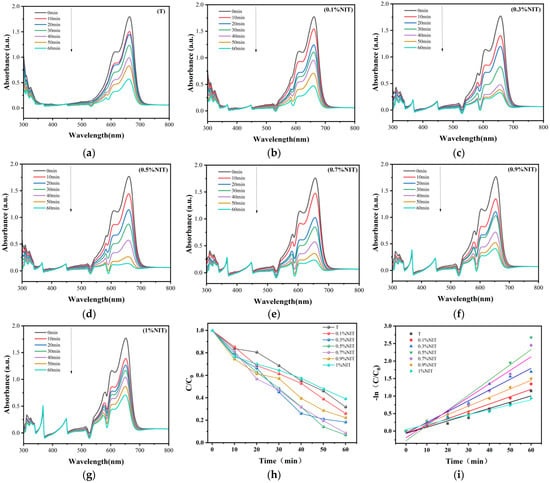
Figure 3.
Continuous UV–Vis spectra of T and NIT samples: (a) T; (b) 0.1% NIT; (c) 0.3% NIT; (d) 0.5% NIT; (e) 0.7% NIT; (f) 0.9% NIT; (g) 1% NIT; (h) MB photodegradation C/C0 curves of different samples; and (i) MB photodegradation diagrams of different samples (C/C0) versus time.
As shown in Figure 3h, pure TiO2 achieves a degradation efficiency of 68.2%. In contrast, NIT catalysts with varying Ni loadings (0.1–1.0 wt%) exhibit MB degradation efficiencies of 74%, 81.7%, 93.1%, 91.4%, 77.7%, and 60.9%, respectively, after 60 min of illumination. The photocatalytic activity initially increases with the Ni content, peaking at 0.5 wt%, followed by a decline at higher doping levels. To quantify the degradation kinetics, the Langmuir–Hinshelwood pseudo-first-order model [39] was applied, as expressed in Equation (2):
where k is the photocatalytic rate and t is the illumination time. The photocatalytic rate of the samples with different nickel contents is shown in Table 1.

Table 1.
Photocatalytic rate of the samples with different NIT content.
As shown in Table 1, the 0.5% NIT-doped sample exhibits the highest reaction rate constant (k) for methylene blue (MB) degradation, followed by the 0.7% NIT-doped sample. The reaction rate constant k, derived from the slope of the pseudo-first-order reaction kinetics, based on the Langmuir–Hinshelwood model, demonstrates a direct correlation with photocatalytic efficiency, higher k values correspond to enhanced catalytic performance. Notably, significant variations in the k values among the samples with different doping concentrations suggest intrinsic correlations with certain material characteristics such as the specific surface area and crystallite size. Extensive studies have revealed that an enlarged specific surface area provides more active sites, thereby facilitating the adsorption of MB molecules on catalyst surfaces and promoting photocatalytic reactions. Concurrently, enhanced light scattering and absorption efficiency achieved through an increased surface area optimize photon utilization, ultimately accelerating the reaction kinetics. Furthermore, reduced crystallite dimensions benefit the diffusion and transport of photogenerated charge carriers by shortening the migration distance from crystal interiors to surfaces. This spatial advantage effectively minimizes the carrier recombination probability, leading to improved photocatalytic activity and elevated k values. It is worth emphasizing that photocatalytic performance is comprehensively influenced by multiple parameters, such as the degree of crystallinity, the number of surface active sites, particle size distribution, bandgap energy, and recombination rates. These interdependent factors collectively govern the photochemical conversion efficiency in heterogeneous catalytic systems.
Based on the experimental results, 0.5 wt% NIT exhibits the highest photodegradation efficiency for MB, followed by 0.7 wt% NIT. This enhancement can be attributed to the incorporation of Ni2+ ions, which suppress the recombination of photogenerated electron–hole pairs and facilitate electron transfer to adsorbed O2 molecules, generating reactive oxygen species. However, excessive Ni2+ doping (>0.5 wt%) leads to a decline in efficiency, likely due to Ni2+ ions occupying active sites or acting as recombination centers, thereby reducing charge separation efficiency [8].
According to relevant studies, the investigation of methylene blue (MB) degradation mechanisms via radical scavengers is a feasible approach to identify the dominant reactive species in TiO2-mediated photocatalytic processes. The primary function of scavengers lies in their ability to selectively trap specific radicals, thereby elucidating the contribution of individual reactive species (e.g., hydroxyl radicals ·OH, superoxide radicals ·O2−, or holes h+) to the overall degradation pathway. When investigating the degradation mechanism of MB using radical scavengers, the adsorption strength of scavengers on TiO2 surfaces and pH variations during the process can exert certain influences on the reaction efficiency. However, most studies implicitly assume that the addition of scavengers is uniformly distributed in the solution, suggesting the influence of a very small amount of scavengers on the TiO2 surface.
To identify the dominant reactive species in the 0.5 wt% NIT photocatalytic system, radical trapping experiments were conducted using isopropyl alcohol (IPA, ·OH quencher), benzoquinone (BQ, ·O2− scavenger), and potassium iodide (KI, h+ inhibitor). Each scavenger (1 mmol/L) was introduced into 100 mL of MB solution (10 mg/L) prior to irradiation. As shown in Figure 4, the degradation efficiency of MB reached 93.1% in the absence of scavengers. Upon adding IPA, BQ, and KI, the efficiencies decreased to 78%, 60%, and 45%, respectively, after 60 min of illumination. The pronounced inhibition effects (KI > BQ > IPA) suggest that h+ and ·O2− serve as the primary reactive species governing MB photodegradation, while ·OH plays a secondary role. Based on these findings, the MB degradation mechanism is proposed as follows [40]:
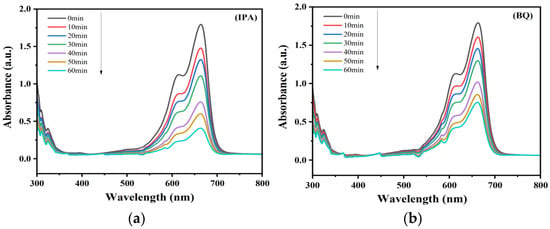
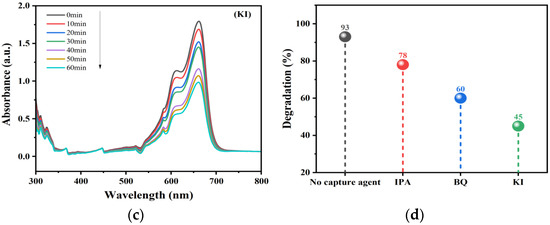
Figure 4.
Continuous UV–Vis spectra with different capture agents: (a) IPA; (b) BQ; (c) KI; and (d) visible-light degradation rate.
3.1.2. Photodegradation of NO
Figure 5a,b illustrates the NO degradation activity of NIT catalysts with Ni2+/Ti4+ ratios ranging from 0.1 to 1.0 wt%. The NO conversion efficiency of Ni–TiO2 exceeds that of pure TiO2, with the 0.7 wt% NIT catalyst achieving the highest NO conversion rate of 45.4% (9.7% higher than pure TiO2). This enhancement is attributed to the substitution of Ti4+ by Ni2+ ions during doping, which narrows the bandgap from 3.2 eV (pure TiO2) to 2.9 eV (NIT). The optimized doping ratio facilitates the formation of shallow potential wells within the TiO2 lattice, thereby enhancing surface reactivity [41].
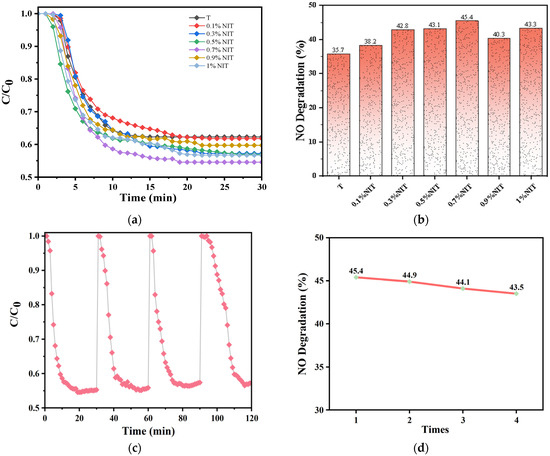
Figure 5.
Photocatalytic degradation of NO by NIT in samples with different doping concentrations (a,b); test results for NO cyclic degradation by 0.7% NIT (c,d).
As shown in the diagram, the NO degradation rate increases correspondingly with the Ni2+/Ti4+ doping ratio (0.1–0.7 wt%), peaking at 0.7 wt% NIT. Beyond this threshold, the degradation efficiency declines. This trend can be attributed to two factors: (1) at low Ni2+ doping levels (<0.7 wt%), insufficient shallow potential wells limit electron–hole pair separation, restricting photocatalytic activity enhancement; (2) excessive doping (>0.7 wt%) induces localized agglomeration, compromising charge transport, and reduces the average distance between trapping sites, thereby significantly enhancing charge recombination and suppressing the photocatalytic efficiency. Furthermore, the NO degradation rate progressively declines and stabilizes with a prolonged reaction time. This behavior likely stems from the rapid generation of strongly oxidizing species (e.g., ·OH and ·O2−) on the TiO2 surface during the initial irradiation, which oxidize NO to nitrate ions (NO3−). The adsorbed NO3− occupies active sites, reducing the degradation kinetics [42]. The proposed NO photodegradation reaction pathways are as follows:
As elucidated by mechanistic studies, the photocatalytic degradation of (NO) over NIT primarily proceeds as a result of oxidation mediated by photogenerated holes (h+) and reactive oxygen species, such as ·OH and superoxide radicals ·O2−. However, this process inevitably generates byproducts, including: (1) NO2 (a highly toxic intermediate oxidation product), (2) N2O (a greenhouse gas formed via incomplete NO reduction), (3) NH3 (potentially generated in strongly reductive conditions), and (4) NO3− (an environmentally benign nitrate, representing the ideal terminal product).
Critical insights from relevant studies reveal that low Ni doping concentrations favor high selectivity toward NO→NO3− conversion, with minimal NO2 emissions and negligible N2O/NH3 formation. This selectivity arises from moderate oxygen vacancy (Ov) concentrations, which enhance ·O2− generation to accelerate deep oxidation of NO, while optimized electronic structures suppress reductive pathways. Conversely, excessive Ni doping reduces NO3- selectivity, elevates NO2 yields, and risks N2O formation. This degradation stems from two factors: (1) NiO impurity phases, formed at high doping levels, act as charge recombination centers that impede deep oxidation; and (2) overabundant defects exacerbate electron–hole recombination and amplify reductive pathways. These findings underscore that precise control of the Ni doping concentration is pivotal to balancing Ov-mediated oxidation enhancement and defect-induced recombination suppression, thereby steering reaction pathways toward environmentally favorable NO3− production.
Figure 5c,d illustrates the cycling stability of NO degradation over 0.7 wt% NIT. After four consecutive cycles, the NO degradation efficiency decreased by only 1.9%, demonstrating exceptional operational stability.
Figure 6 demonstrates the adsorption performance of NIT samples toward methylene blue (MB) and nitric oxide (NO) in dark conditions. As illustrated in Figure 6a, no significant variation in MB concentration was observed without photocatalysts, while the introduction of NIT samples induced a gradual decline in the MB concentration over time, with the 0.3–0.7% NIT samples exhibiting markedly superior adsorption capacities compared to other doping levels. Figure 6b reveals that the NO concentration remained stable in the absence of catalysts, whereas all the NIT-doped samples progressively reduced the NO concentration during adsorption, particularly the 0.5% and 0.7% NIT samples, which showed optimal performance. This adsorption enhancement can be attributed to three principal mechanisms: (1) lattice defects (e.g., oxygen vacancies) generated by Ni2+ substitution for Ti4+ served as electron-enriched regions in darkness, facilitating enhanced chemical bonding interactions with the lone electron pairs of MB amino groups or NO free radicals; (2) Ni2+ species act as active sites for direct coordination adsorption; and (3) distinct adsorption pathways governed by pollutant characteristics, namely MB adsorption primarily involved electrostatic interactions, π-π stacking, and hydrogen bonding, amplified through Ni-induced surface charge modulation and π-conjugated structure optimization, while NO adsorption relied on oxygen vacancy-mediated chemical adsorption (via NO2−/NO3− formation) coupled with physical adsorption. Notably, excessive Ni doping (>0.7%) induced surface over-modification, causing microporous blockage and active site occlusion that compromised the NO adsorption efficiency. These findings demonstrate that Ni doping levels critically regulate adsorption performance through synergistic effects between the pollutant’s molecular properties and the defect state distribution on the material surfaces.
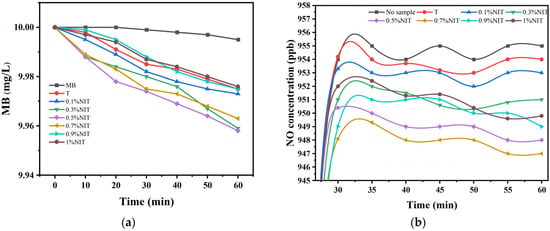
Figure 6.
Adsorption test results: (a) adsorption of MB by different amounts of NIT; and (b) adsorption of NO by different amounts of NIT.
3.2. X-Ray Diffraction Analysis
Figure 7 displays the XRD patterns of TiO2 and Ni-doped TiO2 (NIT), confirming the anatase phase structure. The diffraction peaks at 2θ = 25.3°, 37.9°, 48.2°, 54.0°, 55.2°, and 62.8° correspond to the (101), (004), (200), (105), (211), and (204) crystal planes of anatase TiO2 [43]. Notably, no characteristic peaks of nickel oxide (NiO) are observed in the NIT patterns, indicating that Ni2+ doping does not alter the TiO2 lattice structure, and Ni2+ is likely incorporated into the anatase framework via substitutional doping.
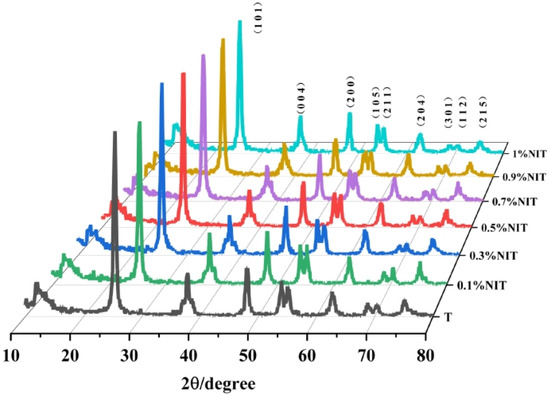
Figure 7.
X-ray diffraction curves of NIT catalysts.
3.3. SEM Analysis
Figure 8 displays the SEM images of pure TiO2 and Ni-doped TiO2 (NIT) with varying Ni2+/Ti4+ ratios (0.1–1.0 wt%). As shown in Figure 8a, pure TiO2 exhibits a granular and near-spherical morphology, with densely aggregated particles and uniform size distribution. Figure 8b–g illustrates the microstructures of the NIT samples (0.1–1.0 wt% Ni2+/Ti4+), revealing no significant differences in the nanoparticle size or distribution compared to pure TiO2. Notably, the 0.7 wt% NIT sample displays a distinct plate-like morphology, which may enhance active site exposure for MB and NO degradation. To our knowledge, this work reports the first synthesis of plate-like Ni–TiO2 via a sol–gel method, combined with mechanical ball milling of the gel precursors.
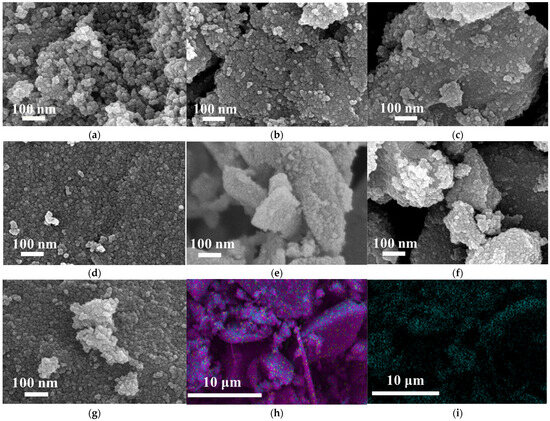

Figure 8.
SEM images of the catalysts: (a) TiO2, (b) 0.1% NIT, (c) 0.3% NIT, (d) 0.5% NIT, (e) 0.7% NIT, (f) 0.9% NIT, (g) 1% NIT; (h–l) elemental mapping and EDS spectra of 0.7% NIT.
Figure 8h–k presents the elemental mapping of 0.7 wt% NIT, demonstrating uniform spatial distributions of Ni and Ti atoms across the plate-like morphology. This homogeneous dispersion facilitates efficient charge carrier transport at the NIT interface. Energy-dispersive X-ray spectroscopy (EDS) analysis (Figure 8l) confirms the coexistence of Ti, O, and Ni in the catalyst. The observed non-stoichiometric oxygen deficiency likely originates from surface oxygen vacancies, which are known to enhance photocatalytic activity by modulating electronic properties.
3.4. UV–Vis DRS Test Analysis
To investigate the influence of the Ni doping content on the optical absorption edge and bandgap of TiO2 nanoparticles, UV–Vis diffuse reflectance spectroscopy (DRS) was conducted on the pure TiO2 and NIT samples. As shown in Figure 9a, pure TiO2 exhibits strong absorption exclusively in the ultraviolet region (λ < 400 nm), with negligible absorption in the visible range (400–500 nm). In contrast, Ni-doped TiO2 demonstrates a progressive redshift in the absorption edge toward longer wavelengths with increasing Ni content. A distinct shoulder-like absorption feature emerges within the 400–500 nm range, accompanied by a significant redshift. Beyond 500 nm, the NIT samples display a broader absorption edge compared to pure TiO2.
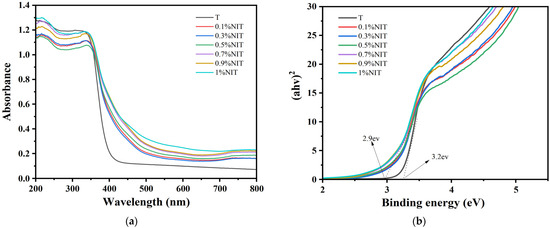
Figure 9.
(a) UV diffuse reflectance spectra of samples with different NIT content; (b) bandgap diagram of samples with different NIT content.
The redshift fundamentally arises from the narrowing of the material’s bandgap, which reduces the energy required for electron excitation (corresponding to longer wavelengths). The observed redshift in the optical absorption edge can be attributed to bandgap narrowing induced by nickel doping in TiO2. Specifically, nickel doping facilitates hybridization between Ni 3d orbitals and Ti 3d orbitals, resulting in a slight downward shift in the conduction band minimum, thereby reducing the bandgap (Eg). Additionally, nickel doping promotes charge transfer transitions between TiO2 and nickel ions across the conduction or valence bands, which require lower energy input, further contributing to the redshift phenomenon. Moreover, the nickel doping process is accompanied by the formation of oxygen vacancies (Ov). These defect states introduce localized energy levels within the forbidden bandgap, effectively reducing the effective bandgap and enhancing visible-light absorption. The resultant redshift facilitates photon energy absorption under visible-light irradiation, thereby stimulating photocatalytic reactions and improving the visible-light utilization efficiency. This phenomenon may also correlate with lattice distortions in TiO2 caused by the incorporation of nickel ions. The synergistic effects of bandgap engineering, defect-induced intermediate states, and structural modifications collectively optimize the photoelectronic properties and catalytic performance of Ni-doped TiO2 systems.
Figure 9b depicts the bandgaps corresponding to varying NIT contents derived from the UV–visible diffuse reflectance spectra. The bandgaps of the structures were calculated using the Tauc formula, where the relationship between the absorption coefficient and photon energy is expressed as follows [44]:
where α is the absorption coefficient, h is Planck’s constant (6.6 × 10−34 J·Hz−1), υ is the frequency of light, and k is a constant, called a band-tail parameter, which depends on the transition probability.
Based on the correlation between the bandgap (Eg) and the light absorption threshold (λg), the λg values for the respective samples were determined [45]:
where Eg denotes the bandgap (eV) and λg represents the light absorption threshold (nm). The λg and Eg values of TiO2 and NIT (0.1–1%) are summarized in Table 2. Notably, Ni-doped TiO2 exhibits an extended light absorption threshold accompanied by a reduced bandgap. Furthermore, progressive nickel incorporation induces systematic threshold redshifts and continuous bandgap narrowing.

Table 2.
Optical absorption threshold and bandgap width of T and different NIT catalysts.
3.5. N2 Sorption Analysis
Extensive studies have demonstrated that the specific surface area, while a critical parameter, is not the sole determinant of photocatalytic efficiency. Although an increased surface area provides foundational conditions for photocatalytic activity, optimal performance necessitates a synergistic interplay with electronic structure optimization and defect engineering. In Ni-doped TiO2 systems, bandgap regulation and the oxygen vacancy concentration typically exert more pronounced contributions to photocatalytic activity than surface area, particularly in visible-light-driven reactions. An expanded surface area generally enhances the exposure of active sites and improves the adsorption capacity, facilitating the surface enrichment of reactants (e.g., methylene blue (MB) or nitric oxide (NO) molecules), thereby elevating degradation efficiency. Consequently, surface area characterization offers a partial yet meaningful reflection of the photocatalytic performance. However, the superior activity observed in Ni-doped TiO2 systems predominantly stems from the synergistic effects of the tailored electronic properties (e.g., narrowed bandgap via Ni 3d–Ti 3d orbital hybridization), optimized charge carrier dynamics (e.g., suppressed recombination via oxygen vacancy-mediated trapping), and structural modifications (e.g., lattice distortion-induced defect states). These factors collectively dominate compared to the surface area effects in regard to governing the photocatalytic behavior under visible-light irradiation.
The porous characteristics of the NIT samples with varying Ni concentrations were analyzed using N2 adsorption–desorption measurements. Figure 10a reveals that all the NIT catalysts exhibit type IV isotherms with type H3 hysteresis loops [46], consistent with their mesoporous characteristics. The pore size distribution profiles in Figure 10b demonstrate narrow pore size distributions (20–50 nm) across all the NIT variants, confirming the preservation of mesoporous architectures irrespective of the Ni doping levels.
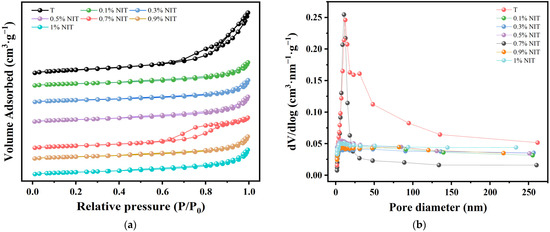
Figure 10.
(a) Nitrogen adsorption and desorption isotherms of samples with different amounts of NIT; (b) pore size distribution in samples with different NIT content.
As shown in Table 3, the BET specific surface area of the Ni-doped TiO2 samples is generally smaller than that of pure TiO2. This can be attributed to the aggregation of metal ions into metallic clusters during the doping process. Moreover, the elevated temperatures during synthesis may induce sintering phenomena in metal-doped TiO2, where the intergranular boundaries disappear, leading to grain coalescence into larger crystallites. Such sintering effects could significantly diminish the specific surface area. These metallic agglomerates may alter the grain size distribution, consequently affecting the surface area characteristics. Although minimal variations in the specific surface area are observed among different Ni-doped TiO2 catalysts, the 0.7% NIT sample exhibits a larger specific surface area (X m2/g) and pore volume (Y cm3/g) compared to other Ni-doped TiO2 catalysts, while maintaining a smaller average pore diameter (Z nm). Notably, the optimal NO degradation efficiency demonstrated by the 0.7% NIT sample in the catalytic tests may originate from the unique combination of its enhanced surface area and optimized pore structure.

Table 3.
Analysis of nitrogen adsorption and desorption results of the samples with different amounts of NIT.
3.6. Raman Analysis
The Raman spectra presented in Figure 11 demonstrate that both pristine TiO2 and the 0.7% NIT samples exhibit a prominent peak at 144 cm−1, along with four characteristic moderate peaks located at 197 cm−1, 398 cm−1, 515 cm−1, and 641 cm−1. These spectral features correspond to the six Raman-active vibrational modes characteristic of anatase-structured TiO2 [47,48]. Comparative analysis with pure TiO2 reveals that the synthesized Ni-doped TiO2 samples exhibit nearly identical Raman features without detectable nickel oxide signatures, confirming that Ni incorporation does not substantially alter the fundamental TiO2 framework, a conclusion consistent with the XRD observations. Notably, the NIT sample exhibits a slight blueshift (~144 cm−1), accompanied by peak broadening and intensity reduction relative to undoped TiO2. This phenomenon may be attributed to lattice defects induced by electron donation from incorporated Ni species, which distort the crystal symmetry. Previous studies have established that heteroatom substitution can generate such structural imperfections, thereby facilitating enhanced electron transfer efficiency and improved catalytic activity [49].
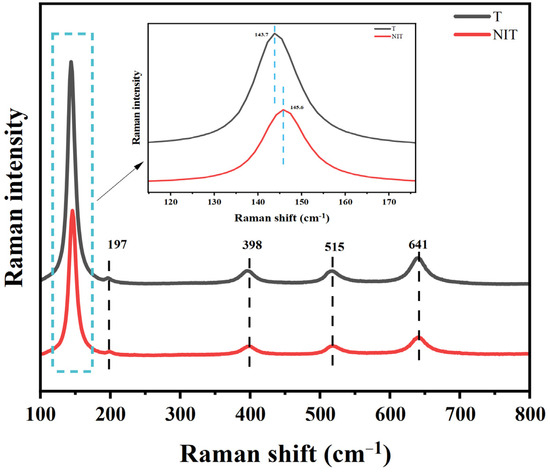
Figure 11.
Raman spectra of 0.7% NIT sample.
3.7. TEM Analysis
To elucidate the microstructure of nickel-doped titanium dioxide, the TEM characterization results for the 0.7% NIT sample are presented in Figure 12. Figure 12a,b reveals a spherical particle morphology with uniform size distribution, demonstrating that Ni doping retains the pristine TiO2 microstructure, a finding consistent with the SEM observations. Figure 12c displays high-resolution TEM images of TiO2 and NiO crystallites. The TiO2 lattice exhibits a d-spacing of 0.35 nm, corresponding to the (101) plane of anatase TiO2. Concurrently, the NiO phase shows a characteristic d-spacing of 0.24 nm, matching the (111) plane of cubic NiO [50]. Figure 12d presents selected-area electron diffraction patterns featuring concentric rings, where measured d-spacings of 0.35 nm and 0.18 nm correspond to the (101) and (211) planes of anatase TiO2, while 0.24 nm and 0.15 nm spacings align with the (101) and (211) planes of NiO, respectively. These TEM analyses confirm the successful Ni incorporation into the TiO2 lattice.
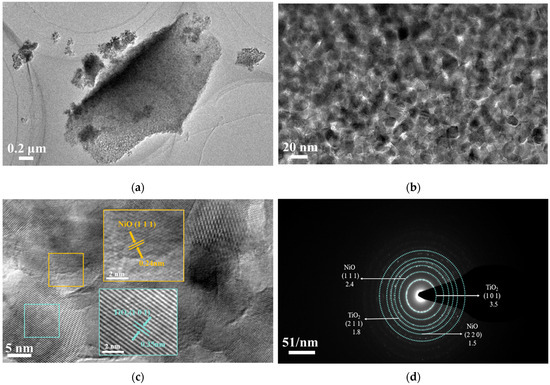
Figure 12.
TEM, HR-TEM, and images of 0.7% NIT sample: (a,b) TEM diagram; (c) Lattice diagram; (d) Concentric diffraction ring.
3.8. XPS Analysis
Figure 13 presents the XPS characterization of the 0.7% NIT sample for chemical state analysis. The survey spectrum (Figure 13a) confirms the presence of Ti, O, Ni, and C elements, showing characteristic Ti 2p (458 eV), O 1s (530 eV), and Ni 2p (850–885 eV) core-level signals, verifying the successful Ni incorporation into TiO2 via sol–gel synthesis. The detected C 1s signal originates from adventitious carbon contamination and/or CO2 adsorption during sample handling. The high-resolution Ti 2p spectrum (Figure 13b) displays spin-orbit split peaks at 458.4 eV (Ti 2p3/2) and 464.1 eV (Ti 2p1/2), confirming the dominant Ti4+ oxidation state. The O 1s spectrum (Figure 13c) deconvolutes into three components: lattice oxygen (Ti-O, 530.3 eV) [51], surface hydroxyl groups (O-H, 531.5 eV) [52], and adventitious carbon-bond oxygen (C-O, 533eV) from sample mounting [53]. The Ni 2p spectrum (Figure 13d) reveals characteristic doublets, with Ni 2p3/2 (854.8 eV) and 2p1/2 (871.1 eV) peaks corresponding to Ni2+ in NiO [54], accompanied by satellite peaks at 857.1 eV and 873.1 eV indicative of Ni3+ species [55] Additional spectral features at 862.1/876.6 eV and 866.5/880.9 eV for Ni 2p3/2 and 2p1/2, respectively, confirm the coexistence of stoichiometric and oxygen-deficient NiO phases [54]. These results conclusively demonstrate nickel incorporation as NiO within the TiO2 matrix.
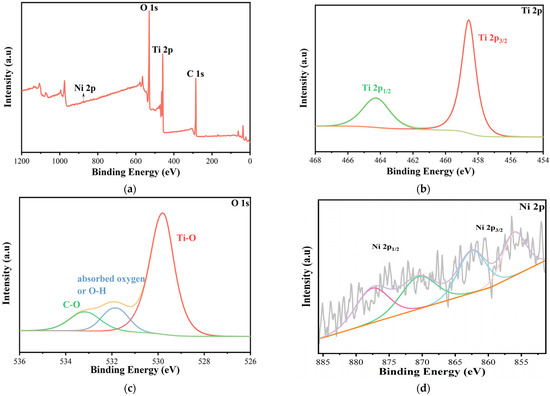
Figure 13.
XPS spectra of 0.7% NIT sample: (a) total spectra of 0.7% NIT; (b) Ti2p; (c) O1s; and (d) Ni2p.
As evidenced by reports in the literature, the Ti 2p3/2 peak typically appears at 458.8 eV. In this study, the XPS analysis of the 0.7% NIT sample reveals a notable shift in the Ti 2p3/2 peak toward a lower binding energy by approximately 0.4 eV, from 458.8 eV to 458.4 eV. Concurrently, the peak intensity corresponding to oxygen vacancies (Ov) exhibits a significant enhancement, indicating an increased oxygen vacancy concentration, which confirms that Ni doping induces structural defects. The Ni 2p3/2 binding energy at 854.8 eV corresponds to the Ni2+ oxidation state, demonstrating successful incorporation of Ni into the TiO2 lattice via substitutional doping at Ti4+ sites. The presence of Ni2+ substantially enhances the photocatalytic activity due to the following mechanisms: (1) Ni2+ substitution for Ti4+ induces lattice distortion, promoting oxygen vacancy formation. These vacancies act as electron traps, effectively suppressing electron–hole (e−-h+) recombination. (2) In contrast, Ni3+ may degrade the photocatalytic performance, as its strong oxidative nature facilitates hole recombination and tends to form unstable phases, such as NiOOH. Excessive structural defects caused by high-valent Ni could disrupt carrier transport.
The reduced Ti 2p binding energy suggests electron density redistribution, which facilitates the separation of photogenerated charge carriers. Additionally, the formation of Ni2+–Ti4+ interfaces enhances charge transfer efficiency, while oxygen vacancies prolong carrier lifetimes by serving as electron capture centers. Furthermore, Ni 3d orbitals introduce impurity energy levels within the bandgap, creating low-energy transition pathways that narrow the bandgap and expand visible-light absorption. These synergistic mechanisms collectively optimize the photocatalytic degradation performance of the 0.7% NIT sample.
4. Conclusions
In summary, nickel-modified TiO2 with varying dopant concentrations was synthesized via the sol–gel method, coupled with mechanical milling. The microstructural analyses confirm that the increasing Ni2+ content preserves the crystallographic phase structure and morphological integrity of TiO2, while introducing lattice defects through heteroatom substitution. The UV–vis diffuse reflectance spectroscopy (DRS) reveals a pronounced redshift with the increasing Ni2+ doping concentration, accompanied by bandgap narrowing from 3.2 eV to 2.9 eV. The photocatalytic evaluation demonstrates superior methylene blue (MB) degradation efficiencies of 93.1% (0.5% NIT) and 91.4% (0.7% NIT) within 60 min. The radical scavenging experiments identify holes (h+) and superoxide radicals (·O2−) as the predominant reactive species. Notably, the 0.7% NIT sample exhibits enhanced NO degradation performance, achieving 45.4% removal within 30 min, a 9.7% improvement over pristine TiO2.
Author Contributions
Conceptualization, F.Y. and C.L.; methodology, F.Y., C.W. and H.D.; formal analysis, L.L.; investigation, F.Y., C.W. and H.D.; data curation, F.Y. and Y.W.; writing—original draft preparation, F.Y., L.L. and Y.W.; writing—review and editing, X.Z. and C.L.; supervision, C.L.; project administration, X.Z. and C.L. All authors have read and agreed to the published version of the manuscript.
Funding
This work was supported by the Science and Technology Research Program of Chongqing Municipal Education Commission (KJZD-K202300709), Chongqing Natural Science Foundation Innovation and Development Joint Fund (CSTB2024NSCQ-LZX0076), and the Joint Training Base Construction Project for Graduate Students in Chongqing (JDLHPYJD2023001).
Institutional Review Board Statement
Not applicable.
Informed Consent Statement
Not applicable.
Data Availability Statement
The research data will be made available on request.
Acknowledgments
The authors thank The Test Center of Chongqing Jiaotong University for the help in sample testing.
Conflicts of Interest
The authors declare that there are no conflicts of interest.
Abbreviations
| NIT | Nickel-doped titanium dioxide |
| MB | Methylene blue |
| NO | Nitric oxide |
| XRD | X-ray diffraction |
| XPS | X-ray photoelectron spectroscopy |
| SEM | Scanning electron microscope |
| TEM | Transmission electron microscope |
References
- Malato, S.; Fernández-Ibáñez, P.; Maldonado, M.I.; Blanco, J.; Gernjak, W. Decontamination and disinfection of water by solar photocatalysis: Recent overview and trends. Catal. Today 2009, 147, 1–59. [Google Scholar] [CrossRef]
- Znaidi, L.; Seraphimova, R.; Bocquet, J.F.; Colbeau-Justin, C.; Pommier, C. A semi-continuous process for the synthesis of nanosize TiO2 powders and their use as photocatalysts. Mater. Res. Bull. 2001, 36, 811–825. [Google Scholar] [CrossRef]
- Zhang, Q.; Gao, L.; Guo, J. Effects of calcination on the photocatalytic properties of nanosized TiO2 powders prepared by TiCl4 hydrolysis. Appl. Catal. B Environ. 2000, 26, 207–215. [Google Scholar] [CrossRef]
- Wang, Z.; Helmersson, U.; Käll, P.O. Optical properties of anatase TiO2 thin films prepared by aqueous sol–gel process at low temperature. Thin Solid Film. 2002, 405, 50–54. [Google Scholar] [CrossRef]
- Cui, S.; Ma, Q.; Chen, H.; Zhang, Y.; Sun, F. Heterojunction g-C3N4/CeO2/Bi2O3 composite for the photocatalytic purification of exhaust gas. Mater. Chem. Phys. 2022, 285, 126081. [Google Scholar] [CrossRef]
- Wang, Y.; Cheng, H.; Hao, Y.; Ma, J.; Li, W.; Cai, S. Preparation, characterization and photoelectrochemical behaviors of Fe (III)-doped TiO2 nanoparticles. J. Mater. Sci. 1999, 34, 3721–3729. [Google Scholar] [CrossRef]
- Plazas-Saldaña, J.; Gordillo-Delgado, F. Nanocomposite of hematite-doped titanium dioxide on carbon for use in cold pigments paints. Mater. Sci. Eng. B 2024, 303, 117235. [Google Scholar] [CrossRef]
- Borgarello, E.; Kiwi, J.; Graetzel, M.; Pelizzetti, E.; Visca, M. Visible light induced water cleavage in colloidal solutions of chromium-doped titanium dioxide particles. J. Am. Chem. Soc. 1982, 104, 2996–3002. [Google Scholar] [CrossRef]
- Ahad, A.; Podder, J.; Saha, T.; Das, H.N. Effect of chromium doping on the band gap tuning of titanium dioxide thin films for solar cell applications. Heliyon 2024, 10, e23096. [Google Scholar] [CrossRef]
- Liu, Y.; Fang, P.; Cheng, Y.; Gao, Y.; Chen, F.; Liu, Z.; Dai, Y. Study on enhanced photocatalytic performance of cerium doped TiO2-based nanosheets. Chem. Eng. J. 2013, 219, 478–485. [Google Scholar] [CrossRef]
- Ali, Z.; ullah Shah, A.; Ali, Z.; Mahmood, A. Influence of Cu modified surface states by sol gel Technique on Photocatalytic Activity of Titanium dioxide. Mater. Chem. Phys. 2020, 249, 123169. [Google Scholar] [CrossRef]
- Frindell, K.L.; Bartl, M.H.; Robinson, M.R.; Bazan, G.C.; Popitsch, A.; Stucky, G.D. Visible and near-IR luminescence via energy transfer in rare earth doped mesoporous titania thin films with nanocrystalline walls. J. Solid State Chem. 2003, 172, 81–88. [Google Scholar] [CrossRef]
- Vanlalhmingmawia, C.; Lee, S.M.; Tiwari, D. Plasmonic noble metal doped titanium dioxide nanocomposites: Newer and exciting materials in the remediation of water contaminated with micropollutants. J. Water Process Eng. 2023, 51, 103360. [Google Scholar] [CrossRef]
- Sun, Z.; Khlusov, I.A.; Evdokimov, K.E.; Konishchev, M.E.; Kuzmin, O.S.; Khaziakhmatova, O.G.; Malashchenko, V.V.; Litvinova, L.S.; Rutkowski, S.; Frueh, J.; et al. Nitrogen-doped titanium dioxide films fabricated via magnetron sputtering for vascular stent biocompatibility improvement. J. Colloid Interface Sci. 2022, 626, 101–112. [Google Scholar] [CrossRef]
- Chakraborty, A.K.; Ganguli, S.; Sabur, M.A. Nitrogen doped titanium dioxide (N-TiO2): Electronic band structure, visible light harvesting and photocatalytic applications. J. Water Process Eng. 2023, 55, 104183. [Google Scholar] [CrossRef]
- Xie, R.; Lei, D.; Zhan, Y.; Liu, B.; Tsang, C.H.A.; Zeng, Y.; Li, K.; Leung, D.Y.; Huang, H. Efficient photocatalytic oxidation of gaseous toluene over F-doped TiO2 in a wet scrubbing process. Chem. Eng. J. 2020, 386, 121025. [Google Scholar] [CrossRef]
- Zhu, M.; Zhai, C.; Qiu, L.; Lu, C.; Paton, A.S.; Du, Y.; Goh, M.C. New method to synthesize S-doped TiO2 with stable and highly efficient photocatalytic performance under indoor sunlight irradiation. ACS Sustain. Chem. Eng. 2015, 3, 3123–3129. [Google Scholar] [CrossRef]
- Sotelo-Vazquez, C.; Noor, N.; Kafizas, A.; Quesada-Cabrera, R.; Scanlon, D.O.; Taylor, A.; Durrant, J.R.; Parkin, I.P. Multifunctional P-doped TiO2 films: A new approach to self-cleaning, transparent conducting oxide materials. Chem. Mater. 2015, 27, 3234–3242. [Google Scholar] [CrossRef]
- Xiang, P.; Lv, F.; Xiao, T.; Jiang, L.; Tan, X.; Shu, T. Improved performance of quasi-solid-state dye-sensitized solar cells based on iodine-doped TiO2 spheres photoanodes. J. Alloys Compd. 2018, 741, 1142–1147. [Google Scholar] [CrossRef]
- Bandara, J.; Hadapangoda, C.C.; Jayasekera, W.G. TiO2/MgO composite photocatalyst: The role of MgO in photoinduced charge carrier separation. Appl. Catal. B Environ. 2004, 50, 83–88. [Google Scholar] [CrossRef]
- Bai, B.; Zhao, J.; Feng, X. Preparation and characterization of supported photocatalysts: HPAs/TiO2/SiO2 composite. Mater. Lett. 2003, 57, 3914–3918. [Google Scholar] [CrossRef]
- Sato, S.; Nakamura, R.; Abe, S. Visible-light sensitization of TiO2 photocatalysts by wet-method N doping. Appl. Catal. A Gen. 2005, 284, 131–137. [Google Scholar] [CrossRef]
- Wang, Q.; Qin, Z.; Chen, J.; Ren, B.; Chen, Q.; Guo, Y.; Cao, X. Green synthesis of nickel species in situ modified hollow microsphere TiO2 with enhanced photocatalytic activity. Appl. Surf. Sci. 2016, 364, 1–8. [Google Scholar] [CrossRef]
- Esfandian, H.; Cherati, M.R.; Khatirian, M. Electrochemical behavior and photocatalytic performance of chlorpyrifos pesticide decontamination using Ni-doped ZnO-TiO2 nanocomposite. Inorg. Chem. Commun. 2024, 159, 111750. [Google Scholar] [CrossRef]
- Mollavali, M.; Falamaki, C.; Rohani, S. Preparation of multiple-doped TiO2 nanotube arrays with nitrogen, carbon and nickel with enhanced visible light photoelectrochemical activity via single-step anodization. Int. J. Hydrogen Energy 2015, 40, 12239–12252. [Google Scholar] [CrossRef]
- Varimalla, S.; Boggala, S.; Manda, K.; Aytam, P.H.; Akula, V. Rutile TiO2 a desirable support for Ni catalyst in the synthesis of γ-valerolactone: Influence of titania crystal phase on the product distribution. Appl. Catal. A Gen. 2023, 662, 119282. [Google Scholar] [CrossRef]
- Gul, T.; Ahmad, S.; Khan, I.; Khan, I.; Almehmadi, M.; Alsaiari, A.A.; Allahyani, M.; Saeed, K. Photodegradation of orange II dye using pn junction NiO/TiO2 composite, and assessment of its biological activities. J. Saudi Chem. Soc. 2023, 27, 101654. [Google Scholar] [CrossRef]
- Yurtsever, H.A.; Erzin, K.; Çiftçioğlu, M. Inverse effects of lanthanide co-doping on the photocatalytic hydrogen production and dye degradation activities of Cu doped sol-gel TiO2. Mater. Sci. Eng. B 2023, 298, 116882. [Google Scholar] [CrossRef]
- El Jouad, M.; Touhtouh, S.; Sadek, O.; Hajjaji, A. Structural studies on varied concentrations of europium doped strontium phosphate glasses. Mater. Today Proc. 2022, 66, 349–352. [Google Scholar]
- Kumar, M.; Kumar, A. Application of preference selection index method in performance based ranking of ceramic particulate (SiO2/SiC) reinforced AA2024 composite materials. Mater. Today Proc. 2020, 27, 2667–2672. [Google Scholar] [CrossRef]
- Katiyar, A.; Kumar, N.; Srivastava, A. Optical properties of ZnO nanoparticles synthesized by co-precipitation method using LiOH. Mater. Today Proc. 2018, 5, 9144–9147. [Google Scholar] [CrossRef]
- Solhaug, K.A.; Chowdhury, D.P.; Gauslaa, Y. Short-and long-term freezing effects in a coastal (Lobaria virens) versus a widespread lichen (L. pulmonaria). Cryobiology 2018, 82, 124–129. [Google Scholar] [CrossRef]
- Suppuraj, P.; Parthiban, S.; Swaminathan, M.; Muthuvel, I. Hydrothermal fabrication of ternary NrGO-TiO2/ZnFe2O4 nanocomposites for effective photocatalytic and fuel cell applications. Mater. Today Proc. 2019, 15, 429–437. [Google Scholar] [CrossRef]
- Manickam, K.; Muthusamy, V.; Manickam, S.; Senthil, T.S.; Periyasamy, G.; Shanmugam, S. Effect of annealing temperature on structural, morphological and optical properties of nanocrystalline TiO2 thin films synthesized by sol–gel dip coating method. Mater. Today Proc. 2020, 23, 68–72. [Google Scholar] [CrossRef]
- Wu, J.; Luo, Y.; Qin, Z. Composite-modified nano-TiO2 for the degradation of automobile exhaust in tunnels. Constr. Build. Mater. 2023, 408, 133805. [Google Scholar] [CrossRef]
- Velázquez-Martínez, S.; Silva-Martínez, S.; Pineda-Arellano, C.A.; Jiménez-González, A.; Salgado-Tránsito, I.; Morales-Pérez, A.A.; Peña-Cruz, M.I. Modified sol-gel/hydrothermal method for the synthesis of microsized TiO2 and iron-doped TiO2, its characterization and solar photocatalytic activity for an azo dye degradation. J. Photochem. Photobiol. A Chem. 2018, 359, 93–101. [Google Scholar] [CrossRef]
- Cheng, X.; Feng, Q.; Ni, W.; Li, X.; Qi, Y.; Zhang, S.; Wu, Q.; Huang, Z. Stable and reliable PEG/TiO2 phase change composite with enhanced thermal conductivity based on a facile sol-gel method without deionized water. J. Energy Storage 2024, 89, 111705. [Google Scholar] [CrossRef]
- Lal, M.; Sharma, P.; Ram, C. Synthesis and photocatalytic potential of Nd-doped TiO2 under UV and solar light irradiation using a sol-gel ultrasonication method. Results Mater. 2022, 15, 100308. [Google Scholar] [CrossRef]
- Di Mauro, A.; Fragalà, M.E.; Privitera, V.; Impellizzeri, G. ZnO for application in photocatalysis: From thin films to nanostructures. Mater. Sci. Semicond. Process. 2017, 69, 44–51. [Google Scholar] [CrossRef]
- Sadikin, S.N.; Ridwan, J.; Umar, M.I.A.; Raub, A.A.M.; Yunas, J.; Hamzah, A.A.; Dahlan, D.; Abd Rahman, M.Y.; Umar, A.A. Photocatalytic activity and stability properties of porous TiO2 film as photocatalyst for methylene blue and methylene orange degradation. Int. J. Electrochem. Sci. 2023, 18, 100246. [Google Scholar] [CrossRef]
- Dong, S.; Chen, S.; He, F.; Li, J.; Li, H.; Xu, K. Construction of a novel N-doped oxygen vacancy-rich TiO2 N-TiO2−X/g-C3N4 S-scheme heterostructure for visible light driven photocatalytic degradation of 2, 4-dinitrophenylhydrazine. J. Alloys Compd. 2022, 908, 164586. [Google Scholar] [CrossRef]
- Khanal, V.; Balayeva, N.O.; Günnemann, C.; Mamiyev, Z.; Dillert, R.; Bahnemann, D.W.; Subramanian, V.R. Photocatalytic NOx removal using tantalum oxide nanoparticles: A benign pathway. Appl. Catal. B Environ. 2021, 291, 119974. [Google Scholar] [CrossRef]
- Kundu, A.; Mondal, A. Structural, optical, physio-chemical properties and photodegradation study of methylene blue using pure and iron-doped anatase titania nanoparticles under solar-light irradiation. J. Mater. Sci. Mater. Electron. 2019, 30, 3244–3256. [Google Scholar] [CrossRef]
- Sharma, S.; Devi, A.; Bhattacharyya, K.G. Nickel-titanium dioxide-Fuller’s earth nanocomposites: Synthesis, characterization and application as a photocatalyst in aqueous methylene blue degradation under visible light irradiation. Inorg. Chem. Commun. 2023, 151, 110550. [Google Scholar] [CrossRef]
- Kuo, C.Y.; Wu, C.H.; Wu, J.T.; Chen, Y.R. Synthesis and characterization of a phosphorus-doped TiO2 immobilized bed for the photodegradation of bisphenol A under UV and sunlight irradiation. React. Kinet. Mech. Catal. 2015, 114, 753–766. [Google Scholar] [CrossRef]
- Liu, S.; Bu, Y.; Cheng, S.; Tao, R. Synthesis of TiO2/g-C3N5 heterojunction for photocatalytic degradation of methylene blue wastewater under visible light irradiation: Mechanism analysis. Diam. Relat. Mater. 2023, 136, 110062. [Google Scholar] [CrossRef]
- Huang, K.; Lin, L.; Yang, K.; Dai, W.; Chen, X.; Fu, X. Promotion effect of ultraviolet light on NO+CO reaction over Pt/TiO2 and Pt/CeO2–TiO2 catalysts. Appl. Catal. B Environ. 2015, 179, 395–406. [Google Scholar] [CrossRef]
- Yu, S.; Yun, H.J.; Lee, D.M.; Yi, J. Preparation and characterization of Fe-doped TiO2 nanoparticles as a support for a high performance CO oxidation catalyst. J. Mater. Chem. 2012, 22, 12629–12635. [Google Scholar] [CrossRef]
- Cheng, G.; Liu, X.; Song, X.; Chen, X.; Dai, W.; Yuan, R.; Fu, X. Visible-light-driven deep oxidation of NO over Fe doped TiO2 catalyst: Synergic effect of Fe and oxygen vacancies. Appl. Catal. B Environ. 2020, 277, 119196. [Google Scholar] [CrossRef]
- Park, J.; Lam, S.S.; Park, Y.K.; Kim, B.J.; An, K.H.; Jung, S.C. Fabrication of Ni/TiO2 visible light responsive photocatalyst for decomposition of oxytetracycline. J. Environ. Res. 2023, 216, 114657. [Google Scholar] [CrossRef]
- Anwer, S.; Bharath, G.; Iqbal, S.; Qian, H.; Masood, T.; Liao, K.; Cantwell, W.J.; Zhang, J.; Zheng, L. Synthesis of edge-site selectively deposited Au nanocrystals on TiO2 nanosheets: An efficient heterogeneous catalyst with enhanced visible-light photoactivity. Electrochim. Acta 2018, 283, 1095–1104. [Google Scholar] [CrossRef]
- Xue, D.; Luo, J.; Li, Z.; Yin, Y.; Shen, J. Enhanced photoelectrochemical properties from Mo-doped TiO2 nanotube arrays film. Coatings 2020, 10, 75. [Google Scholar] [CrossRef]
- Jung, S.C.; Bang, H.J.; Lee, H.; Ha, H.H.; Yu, Y.H.; Kim, S.J.; Park, Y.K. Assessing the photocatalytic activity of europium doped TiO2 using liquid phase plasma process on acetylsalicylic acid. Catal. Today 2022, 388, 365–371. [Google Scholar] [CrossRef]
- Dubey, P.; Kaurav, N.; Devan, R.S.; Okram, G.S.; Kuo, Y.K. The effect of stoichiometry on the structural, thermal and electronic properties of thermally decomposed nickel oxide. RSC Adv. 2018, 8, 5882–5890. [Google Scholar] [CrossRef]
- Wu, C.; Yang, Y.; Feng, W.; Song, W.; Tan, R. Towards superior nickel oxide electrochromic films using Si and Li co-doping and rapid thermal annealing. J. Alloys Compd. 2021, 862, 158665. [Google Scholar] [CrossRef]
Disclaimer/Publisher’s Note: The statements, opinions and data contained in all publications are solely those of the individual author(s) and contributor(s) and not of MDPI and/or the editor(s). MDPI and/or the editor(s) disclaim responsibility for any injury to people or property resulting from any ideas, methods, instructions or products referred to in the content. |
© 2025 by the authors. Licensee MDPI, Basel, Switzerland. This article is an open access article distributed under the terms and conditions of the Creative Commons Attribution (CC BY) license (https://creativecommons.org/licenses/by/4.0/).